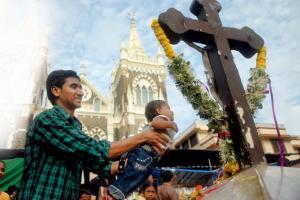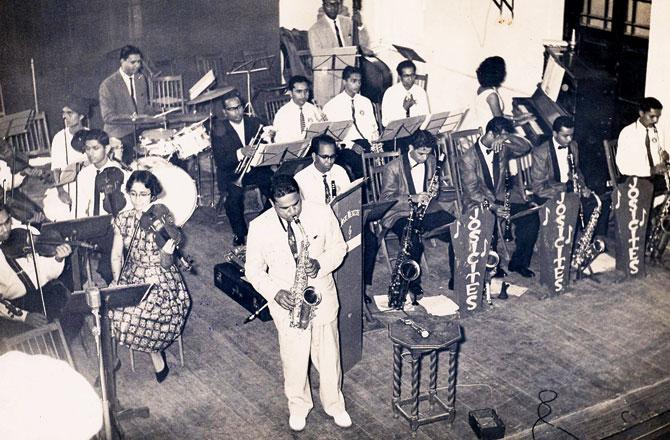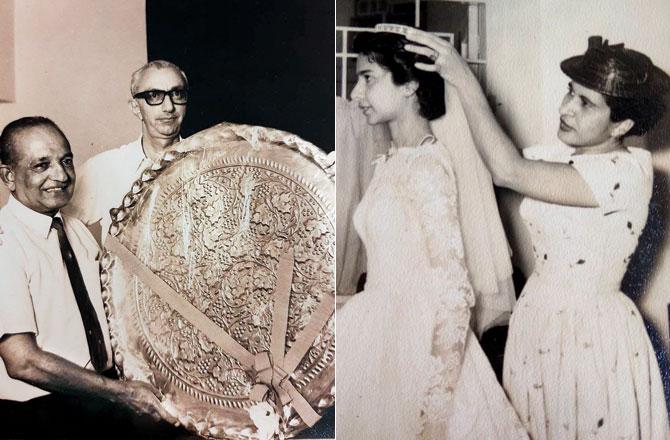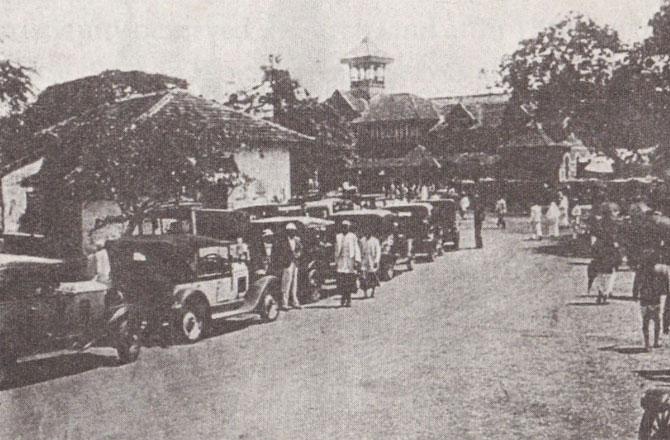How did Bandra icons shape the cultural curve for youngsters growing up here? We count the ways

Devotees of all ages visiting the Mount Mary Basilica
 It would have ended today. Had there been no hiccup in a four centuries-old tradition and the Bandra Fair was held in COVID-free climes, this was the annual week of worship and revelry. Lasting eight days, from the Sunday after the September 8 birthday of Mother Mary to the next, termed Octave Sunday, the fair envelopes the Basilica of Our Lady of the Mount, contoured Neo-Gothic by Shapoorjee Chandabhoy in 1904.
It would have ended today. Had there been no hiccup in a four centuries-old tradition and the Bandra Fair was held in COVID-free climes, this was the annual week of worship and revelry. Lasting eight days, from the Sunday after the September 8 birthday of Mother Mary to the next, termed Octave Sunday, the fair envelopes the Basilica of Our Lady of the Mount, contoured Neo-Gothic by Shapoorjee Chandabhoy in 1904.
That the shrine drew devotees on bullocks or in boats across Mahim creek since early years may be surmised from a 1669 document describing decorated bell-jingling recklas (carts), carrying passengers to the Mount by lantern light. Breaking their tiring trip from gaothans well beyond Bandra, the faithful tethered bovine steeds to rest in cool groves as they trekked uphill. Returning pilgrims were provided snacks that locals kept ready on verandahs prettied for the occasion. Basic diversions for visitors gradually sprouted larger food and games stalls.

Multi-instrumentalist Josic Menzie in a concert. Until the 1980s, Menzie was an extraordinary teacher to generations of budding musicians, some of whom are international celebrities today. Pic courtesy/Celeste Cordo
"We went through the fair, not to the fair," says piano teacher Susan Pinto, her home along a church-to-church axis, from the hallowed altar of the Mount to September Garden shenanigans on Mount Carmel Church grounds. Alongside chana and chaat counters, fixtures like old Santan sizzled sorpotel, sausage fry and spiced pork on the spot for hungry customers.
The Well of Death churned with daredevil stunts executed by Valentine, named nicely matching his hot looks. An Anglo-Indian (a predominant community in 1900s Bandra with Catholics and Parsis), he revved his bike to roll and girls stared goggle-eyed. Giggling at distorted torsos imaged by the Laughing Mirrors booth, we would dizzy ourselves silly on the Ferris Wheel and gawp at older schoolgirls jiving with dreadlocked beaus at jam sessions.

Leo Pinto, field hockey goalkeeper at the 1948 Olympics in London winning India the gold, presented a brass plaque by Homi Dastoor on his retirement from Tatas. The friends were joint honorary secretaries of Tata Sports Club; (right) Lydia Rodrigues giving bride-to-be Yvonne Nazareth of Khotachiwadi a trial fitting before her 1959 wedding. Pic courtesy/AverilL-Ann Gonsalves
Wishful, wistful we are about this week just for now. The Bandra feast hopefully resurrects in a year or two. We permanently miss Bandra icons of incredible stature—people and places moulding generations of us before they glided into the ages.
Every home rang with soaring music and song in some form because budding Bandra musicians learnt from the best Goan maestros. Multi-instrumentalist Josic Menzie (born Josico Menezes in the Seychelles, employed by the Maharaja of Bikaner) was among the first Indians recruited to play with American jazzmen at the Taj. The Sultan of Sax, as he came to be dubbed, was a teacher extraordinaire, an indelible influence on solo and ensemble artistes alike. They assembled from childhood, for individual and group lessons, at his Little Flower colony flat, including my brother Phiroze. Remembering the master's dedication to ticketed concerts for charity, he says, "Selfless, Josic wanted nothing, but for his students to enjoy excelling at music as part of their personal journey."

An early 1930s view of Bandra station, Victorian Gothic with wooden eaves, in the week of the fair. Alighting visitors reached the Mount in vintage taxis seen in the foreground. From The Story of Bandra Feast by Olga Valladares
Menzie founded the Pops Symphony Orchestra in Bandra of the late 1960s, performing classical and popular works brilliantly conceived by him and his pupils. Celeste Cordo, nee Fernandes, who runs the Glee Hive children's choir, acknowledges, "With his encouragement, I started arranging music for varied ensembles when I was very young. Skilled at discovering a child's unique strength, Josic's focus was ear training using solfege, rhythm patterns, sight reading and playing together with others."
Star protege talents groomed by Josic, who went on to wow international music circles, were violinists Marian Pinheiro and Glen Paes, and cellist Gloria Paes. His lead violinist Uttam Singh proved a big-ticket music director in the movie industry. "Josic wouldn't hesitate spending from his pocket to put on a concert," recollects Alan Menezes. "Living in the same building, I could never get away from practising my clarinet and had no excuse being late for a lesson. That taught me reliability and punctuality in life too."
Of course, violin stringing amateurs can leave raggedy nerved those compelled to listen to screechy bow beginnings. Phiroze and my father, who learnt the instrument post-retirement at 75 from 25-year-old Kenneth D'Souza, an accomplished student of Menzie, lucked out with tolerant neighbours. "Play it again, dikra," they urged, even on hearing tinnily tried staccato notes of Czardas, the Hungarian dance piece. Truly, Ardeshir Boman, his wife Khorshed Hormazdi and their seven children considered us more family than the tenants we were.
On centrestage Hill Road, my Deco residence, Trios mall today, shared a busy corner with Bambi Laundry. It stood rowed with colourful florists, quaint Bohra milliners called Pinky Pat and Sam's Honesty Store, Cheap Jack when it was a mere rough plank piled with stationery we grabbed racing to St Joseph's Convent assembly mornings, bakeries and cold storages like Lusitanian and Shalimar. Our building's east wall brushed Boman House, where Ardeshirji, originally from Nasrabad village in Yazd, laid Bombay roots in 1949.
Wonderful landlords, the Iranis laid a beautiful Navroze table, stretching the length of an elegant dining hall, in which occupants of their properties—others being Khoradi, combining the couple's names (Khorshed and Adi), Canara Bank Building and Sunshine—were embraced welcomingly on March 21. The wide doors of the Boman home were fronted by a roofed porch where my mum sometimes companionably chatted with Khorshed Banoo.
Hard to imagine the pastoral picture Hill Road presented. Snakes slithered in grassy meadows on the Elco Arcade acre. Flocks of goats were trotted en masse to the abattoir, then located near the railway station. And down Almeida Road, which we faced (both street and the park tailing it named after Professor Raphael Almeida, renowned botanist, ex-mayor and municipal councillor), came bullocks pulling giant slab loads for the ice factory behind us.
If the soft sound of water swooshing in sheets 24x7 soothed, that factory also sprang a terrifying fright night. An ammonia leak emergency brought us rushing out in pyjamas. Shellshocked, I got an extra kind hug from Elizabeth Menezes, mother of three musically gifted boys across the street. It felt strange seeing her sans the usual accessorised flair of broad-brimmed hat or rainbow-striped parasol above high stilettos. She spoiled me further next noon with chicken patties and lemon sponge from Mac Ronell's. The boast of pioneer confectioner Cajetan Pereira's contribution to 1950s Bandra was the most delectable cakes "shaped from a pipe to a piano".
In a nearby villa, with its verandah trellis curtained by mango and custard apple trees, Lydia Rodrigues crafted classy couture. Her signature styles draped a cosmopolitan clientele in smart suits, pristine white Holy Communion dresses, frilled Navjote frocks and lacy bridal ensembles. Lydia launched the dress-making business in 1952, after the tragic drowning of her two-year -old and her husband's declining health. Training for experience, she travelled daily to Amber Gowns at Colaba owned by her sister-in-law Cassie Perry.
Lydia's mother gave her a sewing machine and she started, with reasonable rates slowly attracting customers. "She offered tea, lemonade and biscuits with a generosity she couldn't afford," says her youngest daughter Averil-Ann. "Lovely christening robes and wedding trousseaus were mum's doing. My friends and I helped, embroidering through Saturday nights, attending 5 am mass at St Peter's and buying breakfast jalebis from Hindu Hotel!"
As demand for Lydia's fine needlework rose in the US, UK, Australia, South America, the Gulf and East Africa, her daughter Marie-Celine partnered with her. Word of the immaculate sartorial skills getting around catapulted Lydia from simple seamstress to Bollywood designer. Smoky-eyed Mala Sinha married in a sari with crystal inlaid poppies and rode in an Impala festooned with huge red and white daisies by Lydia. Tanuja modelled her expert choli cuts, Helen shimmied sultrily in her outfits.
Parveen Babi rocked Namak Halal's razzmatazz gold sequin costume, created by Xerxes Bhathena, fitted to perfection by Lydia. Naina Balsaver, the only Miss India to withdraw from the Miss World pageant as the country protested apartheid, wore Lydia's black Peacock Gown for the 1976 pageant.
Passing Lydia's signboard was inevitable en route to New Talkies for Sunday Picture Society screenings. Born Free and Knock on Wood, with Danny Kaye's mesmeric ventriloquist doll, were favourites. One Hundred and One Dalmations' 1960s Cruella de Vil scared me less than Glenn Close's superbly manic role reprisal in the version my kids devoured. Going to this cinema, notches above rival Bandra Talkies on Linking Road, meant patronising Blue Circle beside. From craving its buttery wafers, we graduated to kebabs at Casbah, the beer bar opposite. A logical step up, bro and his pals assured, after we smuggled our underage selves into New Talkies for "adult" film, The Italian Job.
We had dear friends in the Pinto family, my father especially close to Leo Pinto, Susan's father. They were honorary joint secretaries of Tata Sports Club. Bombay House confirms dad was the institution's longest serving secretary, from 1960 to 1977. Uncle Leo was goalkeeper of the team winning India the field hockey gold at London's 1948 Summer Olympics. Adding a touch of cheer to the year's calendar, 2020 marks the centenary of our entry to the Games. Four athletes and two wrestlers reached the 1920 Antwerp Olympics, facilitated by Sir Dorabji Tata.
Discussing the dramatically changed home turf, Phiroze and I recall familiar charms. Along narrowest paths trundled the green van of Maurice Concessio's Band, sides sprinkled with black-painted musical notes framing the tagline "Music grows where Maurice goes". Chic Chocolate and Ken Mac's trombone player of the 1940s, Maurice formed his 16-member brass troupe in 1964. "He entertained guests for the opening months when Oberoi Sheraton introduced the Supper Club in 1973," says his son Ian."
Bougainvillea-laden lanes were where our parents walked early mornings with biscuits for dogs awaiting them at different cottage gates. Bandra bonhomie meant everyone knew everyone, pooches included. Low whistles brought them bounding for happy hellos with furious tail wags.
Each showed a quirk—Lorenzo leapt highest, Mischief barked shriekiest, Dino sniffed deepest, Star crunched crumbs noisiest...
Goodbye to warm, inviting entranceways blocked by woebegone watchmen guarding towers cooped in cubbyhole cabins. No matter where else we've left for, there will always be a great big space in heart and head that is forever Bandra.
Author-publisher Meher Marfatia writes fortnightly on everything that makes her love Mumbai and adore Bombay. You can reach her at meher.marfatia@mid-day.com/www.mehermarfatia.com
Keep scrolling to read more news
Catch up on all the latest Mumbai news, crime news, current affairs, and a complete guide from food to things to do and events across Mumbai. Also download the new mid-day Android and iOS apps to get latest updates.
Mid-Day is now on Telegram. Click here to join our channel (@middayinfomedialtd) and stay updated with the latest news
 Subscribe today by clicking the link and stay updated with the latest news!" Click here!
Subscribe today by clicking the link and stay updated with the latest news!" Click here!









